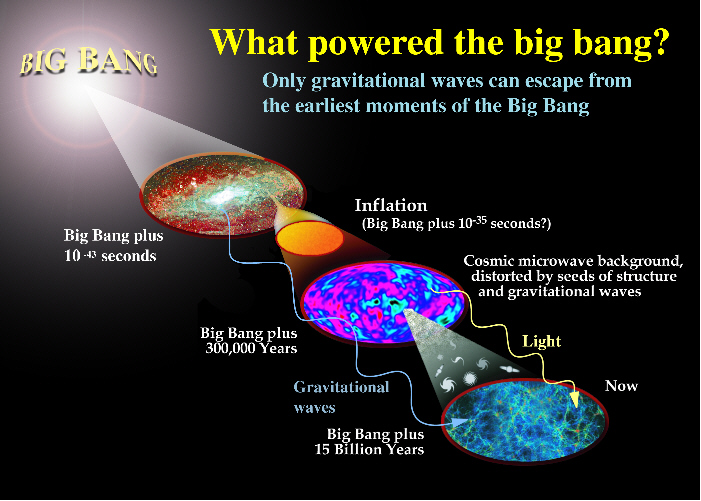
LISA will be able to detect gravitational waves from as far back as 10-36 second after the Big Bang, far earlier than any telescope can detect.

Voices from the Cacophony
By Trudy E. Bell and Dr. Tony Phillips
Around 2015, NASA and the European Space Agency plan to launch one of the biggest and most exacting space experiments ever flown: LISA, the Laser Interferometer Space Antenna.
LISA will consist of three spacecraft flying in a triangular formation behind Earth. Each spacecraft will beam a laser at the other two, continuously measuring their mutual separation. The spacecraft will be a mind-boggling 5 million kilometers apart (12 times the Earth-Moon distance) yet they will monitor their mutual separation to one billionth of a centimeter, smaller than an atom’s diameter.
LISA’s mission is to detect gravitational waves—ripples in space-time caused by the Universe’s most violent events: galaxies colliding with other galaxies, supermassive black holes gobbling each other, and even echoes still ricocheting from the Big Bang that created the Universe. By studying the shape, frequency, and timing of gravitational waves, astronomers believe they can learn what’s happening deep inside these acts of celestial violence.
The problem is, no one has ever directly detected gravitational waves: they’re still a theoretical prediction. So no one truly knows what they “sound” like.
Furthermore, theorists expect the Universe to be booming with thousands of sources of gravitational waves. Unlike a regular telescope that can point to one part of the sky at a time, LISA receives gravitational waves from many directions at once. It’s a cacophony. Astronomers must figure how to distinguish one signal from another. An outburst is detected! Was it caused by two neutron stars colliding over here or a pair of supermassive black holes tearing each other apart in colliding galaxies over there?
“It’s a profound data-analysis problem that ground-based astronomers don’t encounter,” says E. Sterl Phinney, professor of theoretical physics at the California Institute of Technology in Pasadena.
Profound, but not hopeless: “We have lots of good ideas and plans that work—in theory,” he says. “The goal now is to prove that they actually work under real conditions, and to make sure we haven't forgotten something.”
To that end, theorists and instrument-designers have been spending time together brainstorming, testing ideas, scrutinizing plans, figuring out how they’ll pluck individual voices from the cacophony. And they’re making progress on computer codes to do the job.
Says Bonny Schumaker, a member of the LISA team at the Jet Propulsion Laboratory: “It's a challenge more than a problem, and in fact, when overcome, a gift of information from the universe.”
For more info about LISA, see lisa.nasa.gov. Kids can learn about black holes and play the new “Black Hole Rescue!” game on The Space Place Web site at http://spaceplace.nasa.gov/en/kids/blackhole/.

LISA will be able to detect gravitational waves from as far back as 10-36 second
after the Big Bang, far earlier than any telescope can detect.
This article was provided by the Jet Propulsion Laboratory, California Institute of Technology, under a contract with the National Aeronautics and Space Administration.
All content is the responsibility of LUNAR.
If you have comments or suggestions regarding these web pages,
please contact the 
Copyright © 1992 - 2025 LUNAR